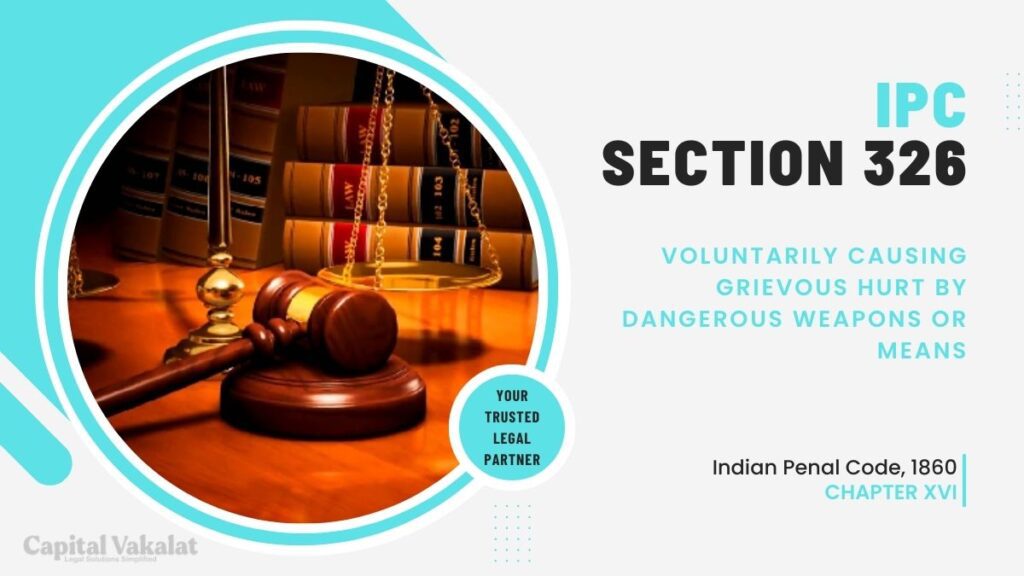In the labyrinth of legal codes, Section 326 IPC stands as a sentinel against heinous acts involving grievous hurt inflicted through dangerous weapons or means. This pivotal section is not merely a legal jargon but a shield for victims and a deterrent for potential offenders.

In this article, we delve into the nuances of Section 326 IPC, exploring its elements, historical roots, legal consequences, and societal impact.
Definition of Section 326 IPC
Section 326 IPC, a segment of the Indian Penal Code, delineates the offense of voluntarily causing grievous hurt using dangerous weapons or means. Grievous hurt, as defined under the IPC, encompasses injuries that are dangerous to life or likely to cause lasting impairment.
Importance of Understanding This Section
A comprehensive grasp of Section 326 IPC is indispensable for both legal practitioners and the general public. It serves as a beacon for justice, holding perpetrators accountable for their actions and providing redress for the victims.
Elements of Section 326 IPC
Voluntarily Causing Grievous Hurt
The crux of Section 326 IPC lies in the term ‘voluntarily.’ Understanding the intent behind the act is crucial in establishing guilt. The section requires proof that the accused consciously intended to cause grievous harm, elevating the offense beyond mere negligence.
Dangerous Weapons or Means
The inclusion of ‘dangerous weapons or means’ adds a layer of severity to the offense. From knives to firearms, any instrument capable of causing grievous harm falls within the ambit of this section.
Historical Background
Origin and Evolution of Section 326 IPC
Tracing its roots back to the colonial era, Section 326 IPC has evolved over time. Amendments and judicial interpretations have shaped its current form, reflecting societal changes and legal advancements.
Landmark Cases Shaping Its Interpretation
Landmark cases have played a pivotal role in shaping the interpretation of Section 326 IPC. Each precedent contributes to the legal landscape, setting standards for future judgments.
Legal Consequences
Punishments Under Section 326 IPC
The severity of the offense is met with corresponding legal consequences. Offenders may face imprisonment, fines, or both, depending on the gravity of the harm inflicted.
Legal Precedents and Case Studies
Analyzing past cases provides insights into the application of Section 326 IPC. From high-profile cases to those in the grassroots, legal precedents offer valuable lessons for the judiciary and law enforcement.
Impact on Victims
Physical and Psychological Consequences
Victims of offenses under Section 326 IPC endure not only physical but also profound psychological trauma. Understanding the holistic impact is crucial for devising effective support systems.
Rehabilitation and Support for Victims
Beyond legal redress, rehabilitation and support mechanisms are vital. NGOs, governmental initiatives, and community involvement play a pivotal role in helping victims rebuild their lives.
Challenges in Enforcement
Investigative Difficulties
Enforcing Section 326 IPC presents challenges in gathering evidence and establishing intent. Addressing these hurdles is essential for the effective implementation of the law.
Loopholes in Legal Proceedings
Examination of legal proceedings reveals potential loopholes that perpetrators might exploit. Identifying and rectifying these gaps is crucial to ensure justice is served.
Awareness and Education
Importance of Public Awareness
Raising awareness about Section 326 IPC is paramount for its effective implementation. Public knowledge serves as a deterrent and encourages reporting of offenses.
Educational Initiatives for Prevention
Prevention is as vital as punishment. Educational initiatives focusing on conflict resolution, anger management, and legal consequences can contribute to a safer society.
Social and Cultural Perspectives
Addressing Societal Attitudes Towards Violence
Societal attitudes towards violence often influence the prevalence of such offenses. Initiatives to address and change these attitudes are crucial for long-term change.
Cultural Influences on the Prevalence of Such Cases
Understanding the cultural context is essential. Cultural influences can either exacerbate or mitigate the occurrence of offenses under Section 326 IPC.
International Comparisons
Similar Laws in Other Jurisdictions
A comparative analysis of laws in other jurisdictions provides insights into different approaches to tackling offenses akin to those under Section 326 IPC.
Lessons and Best Practices
Learning from international experiences can inform potential amendments or improvements in the implementation of Section 326 IPC.
Future Outlook
Proposed Changes or Amendments
As society evolves, so should its laws. Proposals for changes or amendments to Section 326 IPC should be informed by a nuanced understanding of current challenges.
The Role of Society in Preventing Such Offenses
Society plays a pivotal role in preventing offenses under Section 326 IPC. Collective efforts, advocacy, and community engagement are integral to fostering a culture of non-violence.
Conclusion
In conclusion, Section 326 IPC stands as a guardian of justice, holding accountable those who inflict grievous harm through dangerous means. Its historical evolution, legal consequences, and societal impact underscore the importance of a holistic approach to tackle such offenses. As we navigate the complexities of enforcing and understanding this section, let us collectively strive for a society free from the scourge of violence.
Frequently Asked Questions
What is the typical punishment for offenses under Section 326 IPC?
The punishment varies based on the severity of the harm caused but can include imprisonment and fines.
How can community awareness contribute to the prevention of such offenses?
Community awareness can act as a deterrent, encouraging reporting and fostering a culture of non-violence through education.
Are there any international conventions addressing offenses similar to Section 326 IPC?
Some international conventions address crimes against persons, providing frameworks that inform or complement domestic laws.
What initiatives are in place to support victims of offenses under Section 326 IPC?
NGOs, governmental programs, and community support initiatives are essential for the rehabilitation and support of victims.